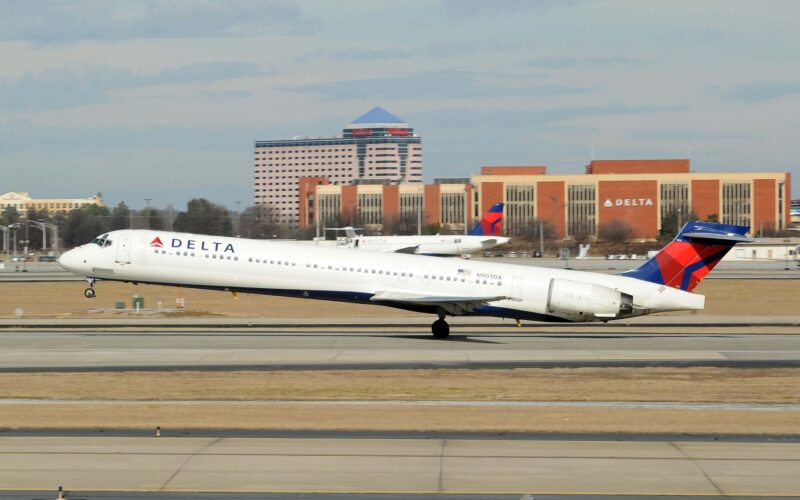The McDonnell Douglas DC-9 family and its many derivatives, including the MD-82, MD-83, MD-88, and MD-90, became the workhorses for United States-based airlines. Now, the first unwanted and turned iconic aircraft is waving its last goodbyes in the United States, as Delta Air Lines is set to retire the type on two special flights, Flight DL88 and Flight DL90, both of which will land at Hartsfield–Jackson Atlanta International Airport (ATL) on June 2, 2020. ATL is Delta’s main hub – from there on, the last Mad Dogs are set to retire at an aircraft boneyard in the United States.
The single-aisle jet was easily recognizable for spotters and for passengers alike. While the former group identified the jet by its oddly looking nose, the shape of the windows and of course the iconic engines at the back of the aircraft coupled with the T-shaped tail, the latter could not mistake its noise for any other, when the rear-mounted engines roared during take-off.
Domestic workhorses
The DC-9 family, which entered commercial service in 1965 with Delta Air Lines, served airlines loyally for quite some time. But even before the coronavirus pandemic sent the global and domestic travel demand spiraling down, the now-renamed MD-80 and MD-90 families were slowly exiting the global commercial aircraft fleet due to their age. The MD-80s, produced by McDonnell Douglas rather than Douglas alone hence the name change, was manufactured till 1999, while the MD-90 was built until 2000.
The jets started to show their age and it was time for them to go. American Airlines (A1G) (AAL) retired its last examples in September 2019. During a grand ceremony, several MD-80s were flown to Roswell International Air Center (ROW) to enjoy their hard-earned retirement under the blazing sun and dry climate of New Mexico. The ceremony for Delta’s farewell to the two types, however, is much tamer. The airline, due to the current circumstances, has blocked the middle seats and select aisle/window seats on all of its aircraft, and limited the capacity of every flight to between 50% and 60%, depending on the aircraft.
Questionable passenger experience
While the MDs worked their engines off throughout the years, they always had questionable passenger experience onboard.
Just like there was little hope for AA’s Dogs to re-enter the fleet then, the chances of Delta’s MDs returning are even slimmer due to the current drop off in demand and every airline’s scramble to save cash during a very difficult period liquidity wise. The old and loud MD-88s and MD-90s are approaching their end-of-life terms, including maintenance expenses and passenger experience – the latter was potentially crossed much sooner than the former, despite the fact that Delta updated its aircraft and even offered Wi-Fi onboard.
Internet service could not save the two aircraft types. On SeatGuru, a website that allows passengers to read more information about seats onboard an airline’s aircraft, users recalled that the Delta’s remaining McDonnell Douglas jets were a “bucket of bolts” and were already “too old”, with limited legroom even in the airline’s premium economy offering.
Whether for their extreme noise onboard, the historical significance of saving American Airlines (A1G) (AAL) and McDonnell Douglas, or the number of hours they spent reliably carrying passengers, they still became an iconic aircraft that will never be forgotten.
Delta Air Lines highlighted that the MD-88 served the airline for over 33 years, with 120 aircraft in its fleet during the years. The MD-90, meanwhile, was present in Delta’s fleet for 25 years, with a total of 65 aircraft. The combined force of the MD-88 and MD-90 served a combined number of more than 600 routes, flying more than 750 million passengers with more than 9,000 pilots qualified to fly the narrow-body.
But just like the Mad Dog family replaced the aging 727s, highlighted by the airline, they are now upgraded to more efficient and much more pleasant to the ear Airbus narrow-bodies, namely the A220 and the A320 families. As of April 30, 2020, Delta Air Lines has 191 of the European manufacturer’s aircraft on order, including 14 A220-100, 50 A220-300, 27 A321ceo and 100 A321neo aircraft.
@delta Captain Carl Nordin makes emotional PA announcement on final delta #MD88 retirement flight. pic.twitter.com/myqCHFyBes
— Chris Sloan (@airchive) June 2, 2020
However, Delta’s story with the MD-90 family is not over yet. The carrier still plans to operate the Boeing 717, or as it was first known when it was launched by McDonnell Douglas, the MD-95. As of June 1, 2020, the company still owns 91 Boeing 717s, out of which 50 are currently parked, planespotters.net data indicates. The airline plans to operate about 30 to 45 jets of the type over the next two years.
The 717’s time might be cut short, however, as the airline could negotiate a deal to replace narrow-body with another Boeing narrow-body, the 737 MAX, reported the Air Current. The deal would end leases on the 717 earlier than contractually agreed and in exchange, Delta would file an order for 100 Boeing 737 MAX aircraft. The possibility of such negotiations is possible due to the fact that the 717s are leased from Boeing Capital Corporation, the leasing and financing arm of Boeing.

